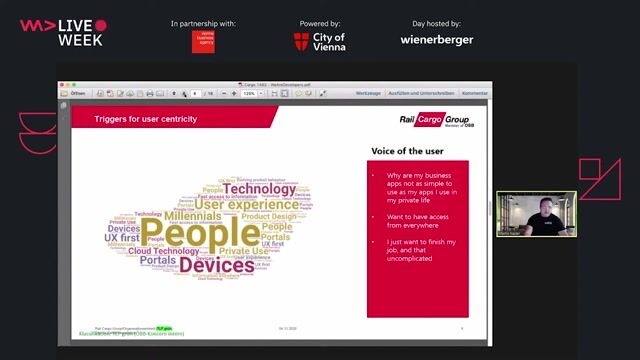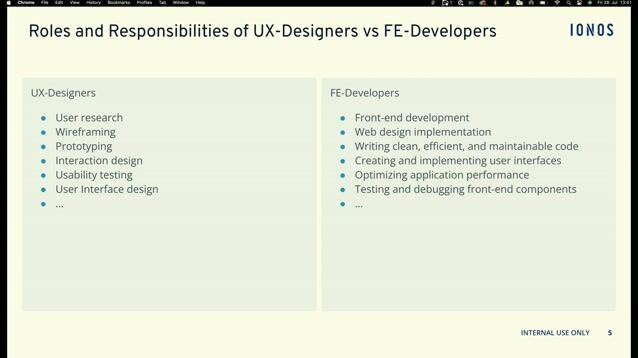Erica Rider & Stan Carrico
Breaking Down Silos Between Design and Development
#1about 4 minutes
The challenge of scaling design at PayPal
PayPal's internal tools team faced a massive 1-to-300 designer-to-developer ratio, requiring an innovative way to scale design.
#2about 5 minutes
Defining the principles of a quality product experience
A quality product must be discoverable, useful, usable, accessible, trustworthy, valuable, desirable, and measurable to succeed.
#3about 4 minutes
Unifying workflows with the DesignOps 2.0 model
The DesignOps 2.0 model merges traditional design and DevOps principles into a single, unified product development workflow.
#4about 7 minutes
Moving from siloed handoffs to collaborative prototyping
Replacing the traditional "telephone game" of requirements with a collaborative model where teams rapidly iterate on prototypes using shared tools.
#5about 3 minutes
Evolving team responsibilities for a customer-focused mindset
Product teams take ownership of user research and prototyping, while the UX team transitions to a mentorship and platform-building role.
#6about 7 minutes
Using a single component library for design and code
A single React component library is used in both the UXPin prototyping tool and Storybook documentation to eliminate drift between design and development.
#7about 6 minutes
Designing components for developers, designers, and end-users
Components must be designed to serve three distinct users: the developer implementing it, the non-technical prototyper, and the final end-user.
#8about 9 minutes
Building an opinionated platform for federated development
The "console" platform uses an SDK and runtime to allow many teams to develop and deploy independently while enforcing UX consistency.
#9about 4 minutes
Applying the equivalent responsibility principle for UX
The entire product team is responsible for the user experience, which encompasses not just UI but also latency, errors, and system performance.
#10about 4 minutes
Driving accountability with metrics and public reporting
Accountability for UX is enforced through mandatory prototyping, heuristic evaluations, baked-in analytics, and transparent public dashboards.
#11about 2 minutes
Summary of breaking down design and development silos
A recap of the five key principles for scaling design, focusing on customer outcomes, a shared component library, and creating shared responsibility.
Related jobs
Jobs that call for the skills explored in this talk.
Matching moments

51:53 MIN
Q&A on shared systems and scaling productivity
Forget Developer Platforms, Think Developer Productivity!

20:14 MIN
Integrating design thinking, agile, and lean UX
The user in the eye of the Cargo1492 storm

23:58 MIN
Key benefits of a collaborative dev and UX process
UX in the Dev Cycle: Moving from Handoff to Handshake

20:01 MIN
Practical steps to integrate UX into development
UX in the Dev Cycle: Moving from Handoff to Handshake

15:31 MIN
How UX collaboration improves developer happiness and quality
UX in the Dev Cycle: Moving from Handoff to Handshake

00:03 MIN
Shifting focus from platforms to developer productivity
Forget Developer Platforms, Think Developer Productivity!

06:29 MIN
Adopting a platform engineering strategy for developer empowerment
Empowering Thousands of Developers: Our Journey to an Internal Developer Platform

09:24 MIN
Breaking down organizational silos with cross-functional governance
We adopted DevOps and are Cloud-native, Now What?
Featured Partners
Related Videos
 06:16
06:16Bridging the Gap
Philipp Kremer
 29:53
29:53Bridging the gap between design and development
Jade Jiang & Noga Mann
 28:35
28:35Unlocking Seamless Collaboration: Design-First APIs for UI Components
Lucien Immink
 57:45
57:45Forget Developer Platforms, Think Developer Productivity!
Robert Hoffmann & Christian Denich
 26:13
26:13UX in the Dev Cycle: Moving from Handoff to Handshake
Malte Breitzmann & Saskia Henatsch
 13:57
13:57DB UX Design System – How we’ve open sourced our largest inner source project
Anna Schoderer & Maximilian Franzke
 56:24
56:24Building Collaborative Open Source tools for Developers and Designers - Pablo Ruiz-Muzquiz from Penpot
Pablo Ruiz-Muzquiz
 26:51
26:51Building the Right Product and Building It Right: A Glimpse into Extreme Programming, Atomic Design
Rita Castro
From learning to earning
Jobs that call for the skills explored in this talk.
![Senior Software Engineer [TypeScript] (Prisma Postgres)](https://wearedevelopers.imgix.net/company/283ba9dbbab3649de02b9b49e6284fd9/cover/oKWz2s90Z218LE8pFthP.png?w=400&ar=3.55&fit=crop&crop=entropy&auto=compress,format)
Senior Software Engineer [TypeScript] (Prisma Postgres)
Prisma
Remote
Senior
Node.js
TypeScript
PostgreSQL

Senior PHP Developer (NL based only)
Online Payment Platform
Delft, Netherlands
€75-95K
Senior
PHP
MySQL
Laravel




Sr Product Experience Designer - Design System (Strato) - Data Visualization
Dynatrace GmbH
Senior
Figma
Product Management


